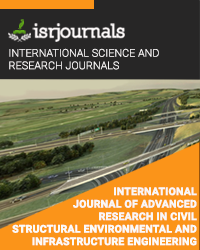compressive strength of nano-silica incorporated recycled aggregate concrete
Bibhuti Bhusan Mukharjee,Sudhirkumar V Barai
Published in International Journal of Advanced Research in Civil,Structural,Environmental and Infrastructure Engineering and Developing
ISSN: 2320-723X Impact Factor:1.7 Volume:2 Issue:1 Year: 08 May,2014 Pages:22-28

Abstract
The present work is based on analysis of the influence of incorporation of Nano-Silica on compressive strength of recycled aggregate concrete using two factorial designs. In this study, recycled coarse aggregate (%), Nano-silica (%) and Specimen Type are selected as factors and each having two levels. Four numbers of mixes with three replicates are designed and compressive strength at seven and 28 days are selected as responses. Analyses of Variance (ANOVA) of experimental results are carried out to study the influence of factors and various plots are used to demonstrate the results of the analysis. The outcome of the study depicts that the selected factors are significantly affecting the compressive strength of concrete. However, the analysis indicates that interaction of factors has no substantial influence on compressive strength of concrete.
Kewords
recycled aggregate concrete, nano-silica, compressive strength, ANOVA.
Reference
[ 1] . N. D. Oikonomou, Recycled concrete aggregates, Cem Conc Compos, 27(2), 2005, pp. 315_318. [ 2] . De Juan M. S. and P. A. Gutiérrez , Study on the influence of attached mortar content on the properties of recycled concrete aggregate, Constr Build Mater, 23(2), 2009, pp 872_877. [ 3] . V. Corinaldesi, Mechanical and elastic behaviour of concretes made of recycled-concrete coarse aggregates, Constr Build Mater, 24(9), 2010, pp. 1616_1620. [ 4] . A. Ajdukiewicz and A. Kliszczewicz, Influence of recycled aggregates on mechanical properties of HS/HPC, Cem Conc Compos, 24(2), 2002, pp. 269_279. [ 5] . S. W. Tabsh and A. S. Abdelfatah, Influence of recycled concrete aggregates on strength properties of concrete, Constr Build Mater, 23(2), 2009, pp. 1163_1167. [ 6] . M. L. Berndt Properties of sustainable concrete containing fly ash, slag and recycled concrete aggregate. Constr Build Mater, 23, 2009, pp. 2609_2613. [ 7] . V. Corinaldesi, G.Moriconi, Influence of mineral additions on the performance of 100% recycled aggregate concrete, Constr Build Mater 23(8), 2009, pp. 2869_2876. [ 8] . F. Pacheco-Torgal, S. Miraldo, Y. Ding and J. A. Labrincha, Targeting HPC with the help of nanoparticles: An overview, Constr Build Mater, 38, 2013, pp. 365_370. [ 9] . M. Stefanidou and I. Papayiann, Influence of nano-SiO2 on the Portland cement pastes, Compos Part B: Eng, 43, 6, 2012, pp. 2706_2710. [ 10] . B. B. Mukharjee, S. V. Barai, Characteristics of Mortars containing colloidal Nano-silica, International Journal of Applied Engineering Research 9(1), 2014, pp. 17_22. [ 11] . B. B. Mukharjee, and S. V. Barai, Influence of Nano-Silica on the properties of recycled aggregate concrete, Constr Build Mater, 55, 2014, pp. 29_37. [ 12] . IS:516, Indian Standard methods of tests for strength concrete, Bureau of Indian Standards, New Delhi, 1959 (Reaffirmed in 1999).

